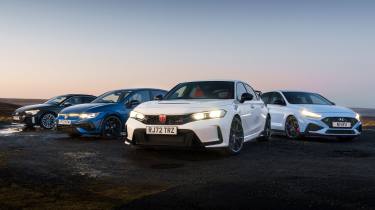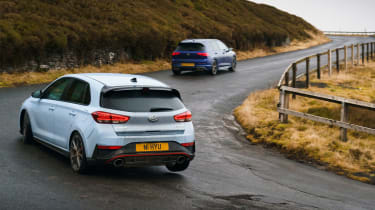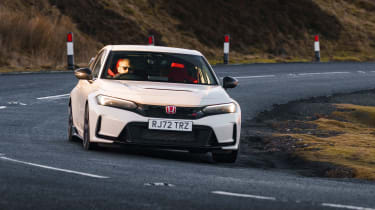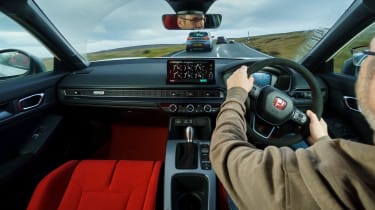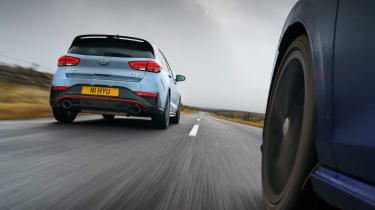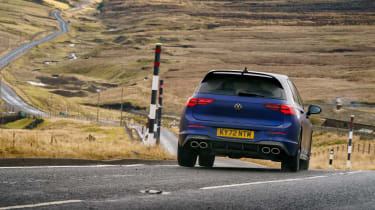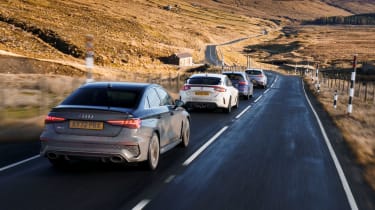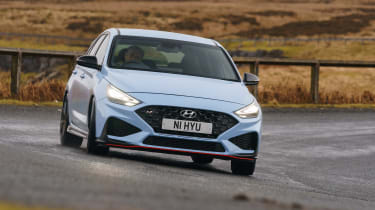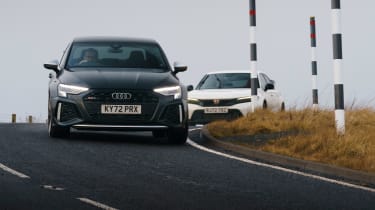Honda Civic Type R v Volkswagen Golf R v Hyundai i30 N v Audi RS3
The all-new FL5-gen Civic Type R is here, and expectations are sky-high. Waiting for it are the rapid and capable Golf R and Audi RS3 and the brilliant Hyundai i30 N
It’s day one, we’ve barely driven the cars, and yet there’s a growing feeling of inevitability about this test. We’ve set up our weighing equipment in one of the PalmerSport garages at the Bedford Autodrome, just next door to the evo office, and editorial assistant Sam Jenkins is running the test cars back and forth. When he arrives with the new Civic Type R he says: ‘Wow… that feels like a hot hatch made by Porsche!’
Colour me unsurprised. The feel of the major controls in the previous FK8 model was superb and in our first drive of the new FL5 in the last issue, Dickie Meaden concluded that Honda’s obsession with the incremental improvement of everything driver-centric had delivered again. He liked the looks, too. I was able to forgive the FK8’s styling because of the way it drove, but for Dickie and a chunk of potential customers it was a deal-breaker.
> Honda Civic Type R sets FWD Nürburgring record (again)
This new model appears wider and lower but crucially less overblown visually, its ‘floating’ rear spoiler more subtle and the detailing less riotous and gratuitous. It’s also better in the metal than pictures, sitting very nicely on its wide tracks, fat wheels and tyres filling its bespoke, BMW M2-like bulging arches. The results of the weigh-in are a surprise. Not that the Audi RS3 saloon is the heaviest of the group at 1597kg with the Volkswagen Golf R ‘20 Years’ edition next on 1529kg, but that the Honda, despite its size, is lighter than the Hyundai, the i30 N 1465kg and the Type R 1437kg. The last FK8 we weighed was 1409kg.
More reviews
The new Civic is considerably more expensive at £46,995 – the FK8 was around £33k – and only a little more powerful at 324bhp but it’s well equipped and the only options are paint colours. The celebratory Golf costs £48,250 but comes with most of the kit you’d want to add to the basic R, though not adaptive damping (£850), while tweaks lift the power to 328bhp. We’d have preferred an RS3 Sportback but the saloon is mechanically identical with its 394bhp in-line five and four-wheel drive, there’s only 5kg difference between them, and at £56,230 the four-door is only marginally more expensive. Bargain of the bunch is the i30 N at £34,595. There were minor cosmetic and HMI upgrades a couple of years ago but the well-judged package with its 276bhp engine continues largely unchanged. If it ain’t broke…
We’re heading north for the Pennines and Hadrian’s Wall, some four hours away. Most of it will be on the A1 but there’s a little bit of interest at either end, so I take the Civic. Settle into the high-backed, deeply bolstered driver’s seat, take a look around and it’s clear that the quality of this model is a cut above the FK8. As it should be. It’s a chunky price increase but before I’ve done a mile or breached 40mph, my objection to the price is already evaporating. There’s such a tangible feeling of quality, of engineering polish about the new Type R that in this respect it’s on another level compared with even the sublime FK8. The steering’s weight, rate and response convey confidence and control, and there’s lovely feedback through the slim, Alcantara-covered rim, while with the alloy gearlever sitting comfortably in your palm, the slick, short-throw gearshift feels instinctive.
The new Type R quickly makes you feel like you’re a relaxed, accomplished driver; precision comes easily, in an unhurried fashion. We’ve banged on about the brake feel of Civics before and the new car’s is even better, with response from the top of the pedal and a weight and progression that helps make your first heel-and-toe downshift as sweet as you could wish. That proud moment is undermined a little by the realisation that there’s a very good, automatic rev-match system but, in reality, the brake feel and the pedal spacing are so good it takes little practice to be as good as the software.
Right now it’s dry, bright and bitingly cold and the roads are white with salt. Carry speed into a large, empty roundabout, turn in keenly, lean on the front and get on the power and the front end pushes back. There’s minimal body roll and the encouraging sense that the front is absolutely pinned, and not at the expense of the rear. The Civic feels all of a piece, hooking up securely when the hammer goes down and jinking through the roundabout with minimal fuss. Wow. I haven’t driven the others and already the test feels won. Thanks for coming, etc.
Twenty minutes later, it’s game on again. I’ve been looking forward to a particular bit of B-road I know well and which regular readers would recognise from photoshoots, relishing creaming the Civic through its sequence of well-sighted bends. So I’m quite unprepared for the uncomfortable lurching over undulating tarmac before we even get there. Dynamically, the Civic is unravelling beneath me, its suspension unyielding, its rear kicked up. I’ve driven countless cars over this road and it’s one of the strongest reactions I’ve experienced. Thing is, we’re heading for roads that are similarly challenging.
Had we stuck to A-roads, the Honda would have continued to build its lead as we headed north. In Type R fashion, its cockpit features bright red seats, belts and carpets but it’s a step up from previous models in design and quality. The stylish, honeycomb metal grille that spans the facia cleverly disguises the air vents, though it does draw your attention to the increased width. Simple, clear dials in a configurable dash are complemented by user-friendly HMI, including a central screen with a volume knob and two major buttons that give haptic feedback, so you can find them without looking and know when you’ve pressed them. Good stuff.
Day two dawns dark and wet. I decide to stick with the Honda for the ‘commute’ to the first location to get a feel for it in less than ideal conditions. I’m tucked up behind the Hyundai as we clear Hexham and begin to hack across country, and the Civic is coping well in Comfort mode. Feels potent, too. The engine is turbocharged but has the characteristics of a naturally aspirated engine. Low down, boost and torque build quickly but not explosively, but keep the throttle open and the delivery builds to a thrilling climax, a series of shift lights and a beeper adding to the excitement.
Traction is pretty good, too, a little over-speeding permitted to give a sense of the grip available, so why can’t I get anywhere near the Hyundai? Ahead, its bright red brake lights pierce the gloom, the air crackles with overrun pops like small arms fire, and it snicks into another tight, wet turn. In search of greater composure, on the next straight I find and press the R button. It’s a mistake: the dampers firm up and the Civic starts to jolt against the lumpy, glistening asphalt. I back off and toggle back to Comfort.
Jordan Katsianis looks happy and relaxed when he hops out of the i30 N, and when I hop out of it 20 minutes later, I look the same. The Honda and Hyundai share some similarities, the first being that they both have low-slung driving positions, the second that they both sound quite ‘open’ – tyre noise and gravel ping suggest less sound deadening – but the main thing they both have is steering that brims with feel and feedback.
Initially I thought the Hyundai was a bit noisy and a bit bumpy but it starts in Sport, which opens up the tailpipes and tightens up the dampers. Select Normal and you have a very easy-going fast hatch. A fast hatch that doesn’t have the highest quality interior, sure, but it costs £35k, not getting on for £50k. It’s not short of features though; its drive modes include ‘Custom’ that brings up a spider’s web graphic that allows you to set a number of parameters including damping, eLSD and exhaust note. But here’s the thing: this is all tinkering around the edges because this is an intrinsically well-sorted fast hatch with a baked-in level of connection and engagement that makes any drive entertaining and rewarding. It starts with the steering, which has feel and directness, and extends to the chassis, which is responsive and transparent in its performance. You know where you are with this car at all times.
It’s properly punchy and fast, too, despite having ‘only’ 276bhp, and the manual gearshift is snappy and great to use, with rev-matching to make up for sub-optimal pedal spacing. All of this shouldn’t come as a surprise; after a series of group tests to find the best hot hatch of 2021, we crowned the i30 N the champion. Even up against the new Civic, it shines bright as a brilliant hot hatch.
Regular evo contributor Peter Tomalin has just climbed out of the most powerful car here, the 2.5-litre, near-400bhp Audi. ‘Switched straight from the Golf to the RS3 and immediately felt like I was stepping up a division,’ he says. ‘The damping’s so much meatier, it’s properly quick, more incisive on turn-in, and it’s got immense traction that really drives you through the corners and fires you onto the next straight. I love the feeling of the rear coming into play too.’ I think we can say he’s a fan.
Jordan has just got out of said Golf and says it’s better than the last R he drove, which is good to hear. We came up here with the original Mk8 and it was bamboozled by the roads and annihilated by the FK8 Civic (evo 288). In the same shade of blue, the 20 Years edition looks almost identical, differentiated only by ‘20’ logos on the B and C-pillars, though if you choose white you get blue wheels. It’s soon apparent that there has been some worthwhile fettling of the drivetrain, though first you’ve got to make your peace with the dreadful HMI. Within a mile on a twisty road you’ll unintentionally turn on the heated steering wheel and probably change drive mode as your hands roll over the haptic switches on said steering wheel.
After the Civic or i30, the Golf’s steering initially feels numb and there’s not enough damping, so the front wheels feel a bit loose, distracted as they unload over bumps and crests, while sharp bumps punch through. It doesn’t help that the Golf feels taller and so sits you higher. Press the blue R button (intentionally) and the car is transformed, with firmer, more consistent damping and more front-end positivity thanks to an uplift in steering weight. Yet despite having on-demand four-wheel drive and a drift mode, the Golf feels more front-driven, more nose-centric, than the Honda or Hyundai.
All of these cars have a drive mode that lets you mix-n-match characteristics such as damper firmness, steering weight and exhaust noise, but experimentation reveals that on these often gnarly roads, the optimum settings for the Golf are provided by Sport. It’s the Goldilocks setting. Almost. Just go for the Race engine setting for response and a bit more noise (not the fake warble that was piped through the speakers in the previous Golf R) and it feels punchy, the DSG shifts much snappier than before.
Peter has bagged the Hyundai for the drive back to base and I’m going to tail him in the RS3. Audi has made some fine looking wheels for its RS models but these fancy 19s make the little saloon look like a GLX rather than an RS. Fire it up, though, and the five-cylinder warble instantly conjures images of Ur-Quattros blatting through forest stages. Yet engine aside, the RS3 feels so tame, so vanilla in key-on mode, the only aggression coming from the ludicrously intrusive lane keeping assist. For the feeling that you’re getting what you’ve paid for, you need to invoke RS mode.
In an instant the engine has its voice and response, the chassis feels planted and you can get on with the business of driving. As much as an illustration of how stiff the Honda is, the firmest damping in the RS3 is about the same as Comfort mode in the Civic. It does feel well controlled so you can exploit the performance, yet there’s a layer of refinement that keeps you from feeling fully a part of the action. The steering is accurate and with the dampers toughened up you can guide it precisely, but there’s still not much to tell you what grip there is. The road is twisting and challenging and I’m jealous of Peter in the Hyundai.
The Audi is properly quick and sounds glorious but the DSG shifts are a bit stodgy. Traction is phenomenal so you find yourself getting on the throttle earlier and earlier, and while the Honda overspeeds its wheels when its engine hits big, the Audi seems to have already shared some of the torque with the rear axle. As with the Golf, you can select an oversteer mode, RS Torque Rear. In the Golf it all feels a bit fraught, in the RS3 more an extension of its dynamics, though on this car we couldn’t always access the mode for some reason.
The i30 N doesn’t need a special mode to feel agile and engaging. It looks sorted from where I’m sitting and Peter has found it very much to his taste. ‘Coming to this after the two Germans, it feels like it’s fairly fizzing with energy. Its chassis has a loose-limbed feel, its steering is alive with sensations and you’ve got a really sweet-shifting manual gearbox to play with. Add a rorty engine with plenty of vim and a saucy soundtrack and it’s just an absolute hoot. Yes, the interior feels a bit low-rent in this company, and it can get a little ragged in extremis, but I love it.’
Next morning I make sure I have the Hyundai key. It’s a straightforward, no-nonsense hot hatch, executed brilliantly. You know where you are with it at all times. Well, almost all times. Our rendezvous point is on an unusually smooth, flowing bit of Pennine B-road and I’m revelling in the i30’s enthusiasm to drop into cambered turns and scrub off speed to make the apex. Then into one I’m a tad ambitious and the tail edges out. Opposite lock goes on and off before I’ve even thought about it. I can’t say I didn’t know where the limit was…
Naturally, I want to try the Honda here too. The Hyundai has great feel but the remarkable quality of the Honda’s steering – the quality of all its controls in fact – is apparent within yards. And it’s faster, its acceleration more aggressive, its grip stronger, its roll control tighter. You spy a very late apex and take aim, the car drops into the shallow dip all-of-a-piece, barely smudges wide as the lateral and compression loads hit and you clip that apex. It’s astonishing. The balance, the composure, the lack of roll, the lack of drama. I strikes me that it feels more like a Super Tourer than a hot hatch.
After two such engaging cars, the lack of connection in the Golf is glaring. What’s going on at the front wheels remains a mystery, so while you guide the Civic and i30 with an easy precision, ticking off every apex, progress in the Golf is disappointingly less precise. It’s a fast car, building torque very quickly so that by 2000rpm there’s grip-bothering grunt, and the urge is delivered in a very linear manner. The DSG is very good too, but it robs the driver of another interaction. In this test it’s a distant fourth. ‘If you drove it in isolation you’d think it was perfectly OK – apart from the awful HMI, obviously,’ says Peter. ‘It’s well built, comfortable and quick. It’s just when you jump into any of the others that you realise what’s missing, and that’s true excitement and engagement.’
Third is the RS3. It’s a cut above the Golf; lower slung, with greater poise, more agility and fantastic traction – very Quattro. And in sound too, of course, with that charismatic, five-cylinder brogue. ‘The slightly stodgy steering robs it of a little edge, as do the surprisingly ponderous gearchanges,’ says Peter, ‘but there’s still lots to enjoy and it’s rabidly quick point to point.’ That’s true, but it’s not enough when you come up against two of the best hot hatches ever made.
It’s almost five years since Hyundai launched the i30 N and it’s still a great drive, illustrating how well its engineers understood the brief, and how well they delivered on it. ‘The i30 N is the moral victor,’ says Peter. ‘I reckon you’d have more fun more of the time in this than any of the others; it’s intimate, transparent and thoroughly engaging.’ It is a remarkable car, a hot hatch in the classic sense, a car that’s fun when you’re dawdling and brilliant when you’re pushing on. ‘Every time, I got out of it with a grin on my face,’ says Jordan. It makes everything else here look too expensive.
OK, not quite everything. The Civic Type R oozes star quality and feels special the moment you drop into the seat and then gets even better once the wheels are rolling. Sure, it looks expensive compared with the FK8 but the feel of its steering, brakes, gearshift and even its throttle are exquisite and of a quality rarely found at any price. And it’s thrillingly fast, ridiculously grippy and unshakeably composed… on the right road. Its undoing is difficult, undulating asphalt: it’s simply too stiff for some of our roads. Both Peter and Jordan felt it was like the Cayman GT4 RS on eCoty, just not as extreme. And yet all three of us would take it over the Hyundai, because it feels so very special and, on the right roads, extraordinarily good.
Specs
| Volkswagen Golf R | Hyundai i30 N | Honda Civic Type R | Audi RS3 | |
| Engine | 4-cyl, 1984cc, turbocharged | 4-cyl, 1998cc, turbocharged | 4-cyl, 1996cc, turbocharged | 5-cyl, 2480cc, turbocharged |
| Power | 328bhp @ 5200rpm | 276bhp @ 5500-6000rpm | 324bhp @ 6500rpm | 394bhp @ 5600rpm |
| Torque | 310lb ft @ 2100-5500rpm | 289lb ft @ 2100-4700rpm | 310lb ft @ 2500-4000rpm | 369lb ft @ 2250-5600rpm |
| Weight | 1555kg (1529kg as tested) | 1419kg (1465kg as tested) | 1429kg (1437kg as tested) | 1570kg (1597kg as tested) |
| Power-to-weight | 214bhp/ton | 198bhp/ton | 230bhp/ton | 255bhp/ton |
| 0-62mph | 4.6sec | 5.9sec | 5.4sec | 3.8sec |
| Top speed | 168mph | 155mph | 171mph | 155mph |
| Basic price | £48,250 (‘20 Years’) | £34,595 | £46,995 | £56,230 (saloon) |
This story was first featured in evo issue 307.

